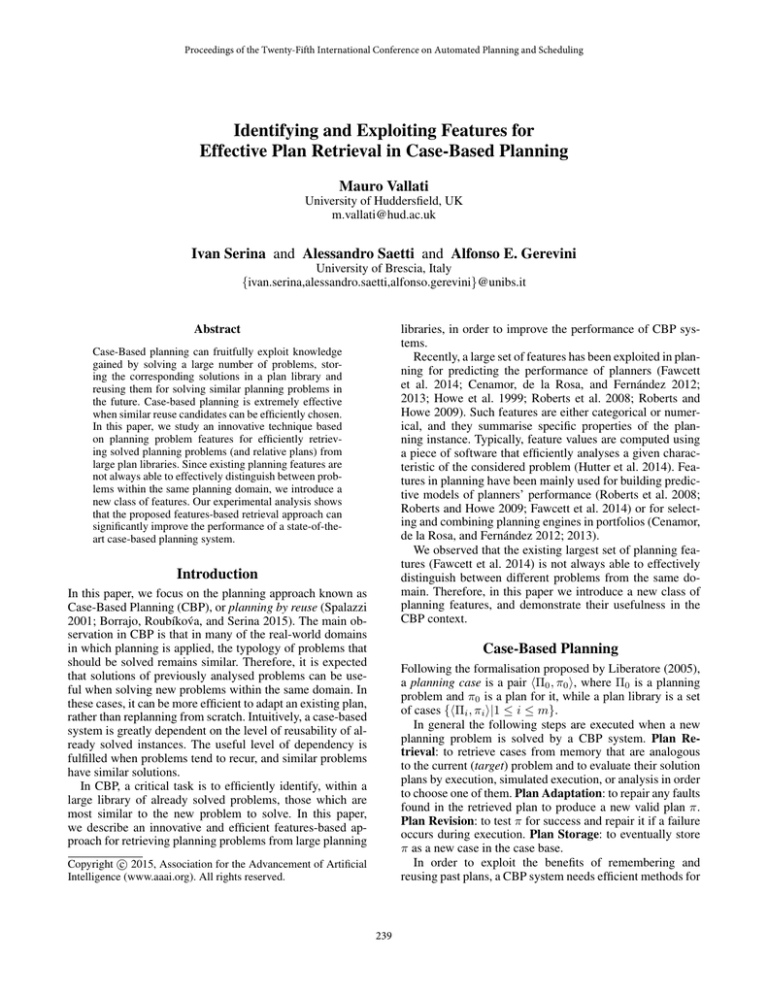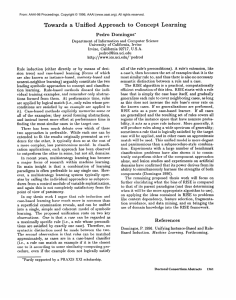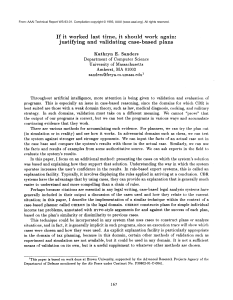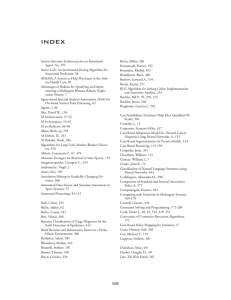
Proceedings of the Twenty-Fifth International Conference on Automated Planning and Scheduling
Identifying and Exploiting Features for
Effective Plan Retrieval in Case-Based Planning
Mauro Vallati
University of Huddersfield, UK
m.vallati@hud.ac.uk
Ivan Serina and Alessandro Saetti and Alfonso E. Gerevini
University of Brescia, Italy
{ivan.serina,alessandro.saetti,alfonso.gerevini}@unibs.it
Abstract
libraries, in order to improve the performance of CBP systems.
Recently, a large set of features has been exploited in planning for predicting the performance of planners (Fawcett
et al. 2014; Cenamor, de la Rosa, and Fernández 2012;
2013; Howe et al. 1999; Roberts et al. 2008; Roberts and
Howe 2009). Such features are either categorical or numerical, and they summarise specific properties of the planning instance. Typically, feature values are computed using
a piece of software that efficiently analyses a given characteristic of the considered problem (Hutter et al. 2014). Features in planning have been mainly used for building predictive models of planners’ performance (Roberts et al. 2008;
Roberts and Howe 2009; Fawcett et al. 2014) or for selecting and combining planning engines in portfolios (Cenamor,
de la Rosa, and Fernández 2012; 2013).
We observed that the existing largest set of planning features (Fawcett et al. 2014) is not always able to effectively
distinguish between different problems from the same domain. Therefore, in this paper we introduce a new class of
planning features, and demonstrate their usefulness in the
CBP context.
Case-Based planning can fruitfully exploit knowledge
gained by solving a large number of problems, storing the corresponding solutions in a plan library and
reusing them for solving similar planning problems in
the future. Case-based planning is extremely effective
when similar reuse candidates can be efficiently chosen.
In this paper, we study an innovative technique based
on planning problem features for efficiently retrieving solved planning problems (and relative plans) from
large plan libraries. Since existing planning features are
not always able to effectively distinguish between problems within the same planning domain, we introduce a
new class of features. Our experimental analysis shows
that the proposed features-based retrieval approach can
significantly improve the performance of a state-of-theart case-based planning system.
Introduction
In this paper, we focus on the planning approach known as
Case-Based Planning (CBP), or planning by reuse (Spalazzi
2001; Borrajo, Roubı́kov́a, and Serina 2015). The main observation in CBP is that in many of the real-world domains
in which planning is applied, the typology of problems that
should be solved remains similar. Therefore, it is expected
that solutions of previously analysed problems can be useful when solving new problems within the same domain. In
these cases, it can be more efficient to adapt an existing plan,
rather than replanning from scratch. Intuitively, a case-based
system is greatly dependent on the level of reusability of already solved instances. The useful level of dependency is
fulfilled when problems tend to recur, and similar problems
have similar solutions.
In CBP, a critical task is to efficiently identify, within a
large library of already solved problems, those which are
most similar to the new problem to solve. In this paper,
we describe an innovative and efficient features-based approach for retrieving planning problems from large planning
Case-Based Planning
Following the formalisation proposed by Liberatore (2005),
a planning case is a pair hΠ0 , π0 i, where Π0 is a planning
problem and π0 is a plan for it, while a plan library is a set
of cases {hΠi , πi i|1 ≤ i ≤ m}.
In general the following steps are executed when a new
planning problem is solved by a CBP system. Plan Retrieval: to retrieve cases from memory that are analogous
to the current (target) problem and to evaluate their solution
plans by execution, simulated execution, or analysis in order
to choose one of them. Plan Adaptation: to repair any faults
found in the retrieved plan to produce a new valid plan π.
Plan Revision: to test π for success and repair it if a failure
occurs during execution. Plan Storage: to eventually store
π as a new case in the case base.
In order to exploit the benefits of remembering and
reusing past plans, a CBP system needs efficient methods for
c 2015, Association for the Advancement of Artificial
Copyright Intelligence (www.aaai.org). All rights reserved.
239
retrieving analogous cases and for adapting retrieved plans
together with a case base of sufficient size and coverage to
yield useful analogues. The ability of the system to search
in the library for a plan suitable to adaptation depends both
on the efficiency/accuracy of the implemented retrieval algorithm and on the data structures used to represent the elements of the case base.
G At
Obj1
Aport2
Obj2
Aport1
Aport3
Obj3
Obj4
Aport4
Plane1
I At
Limits of Existing Features in the CBP Context
Figure 1: PEG of Problem1.
As a matter of fact, in case-based planning selecting the
problems of the case base which are mostly similar to the
new given problem is of critical importance. In particular,
the retrieval step deals with this process. Current techniques
are either expensive or imprecise. In the former case, spending too much CPU-time in the retrieval, dramatically reduces
the CPU usage of subsequent steps. In the latter case, the
number of similar problems provided can be extremely large
and/or not including the most similar problem.
Given the results achieved by Fawcett et al. (2014) in
predicting planners’ performance, we initially decided to
consider all the features they exploited. Thus, for each
planning problem of the case base, 311 features are extracted. Such features represent the largest set of planning
features ever considered. The features that Fawcett et al.
exploited come from a number of different sources. They
computed features by (a) considering different encodings
of a planning problem (PDDL, SAT, SAS+) (Bäckström
and Nebel 1995), (b) extracting pre-processing statistics,
(c) analysing the search space topology (Hoffmann 2011b;
2011a), and (d) considering probing features – brief runs of a
planner on the considered problem, in order to extract information from its search trajectories. Their computation can
take up to few minutes, according to the domain and the size
of the considered problem.
Interestingly, we observed that this large set of features
is often not accurate enough to distinguish between similar
problems from the same domain. In some domains, when
problems have the same number of objects, but differences
in terms of goals and/or initial predicates, the values of all
the features remain exactly the same. Hence, regardless to
the function used for evaluating the similarity, such problems are indistinguishable. In fact, Fawcett-et-al features
were designed for inter-domain exploitation, thus they are
not capable of distinguish, under some conditions, similar
problems within the same domain. We noticed that this is
the case in Logistics-like domains.
Consider two Logistics problems involving four objects “obj1, obj2, obj3, obj4”, four airports “Aport1,
Aport2, Aport3, Aport4” and one airplane “plane1”. In
both problems the goal requires to have all the objects at
“Aport2”, while their corresponding initial state is:
These problems are indistinguishable using the Fawcett
et al. features, but they are significantly different from a
CBP perspective. Clearly, this example involves trivially
small instances, and the different adaptation cost between
plans solving the two problems is irrelevant. Adaptation cost
becomes relevant when indistinguishable problems involve
hundreds of objects and numerous predicates in the initial or
goal states are different.
Identifying features for CBP
Since in case-based planning it is critical to identify and order problems also on the basis of differences that are not
revealed by existing planning features – this is of paramount
importance for minimising the cost of evaluation and adaptation steps – we had to consider other features. We focused on investigating information that can allow a finest
intra-domain problem characterisation. In OAKPlan (Serina
2010), each case in the case base is encoded as a Planning
Encoding Graph (PEG). The underlying idea of the PEG
is to provide a description of the “topology” of a planning
problem without making assumptions regarding the importance of specific problem features for the encoding. The
PEG of a planning problem Π is the union of the directed
labelled graphs encoding the initial and goal facts.
In Fig. 1 we can see the PEG of the Problem 1 of our
running example where the edges associated to initial facts
are depicted with black lines and the edges associated to
goal facts are depicted with dashed red lines. The first and
last level nodes correspond to initial and goal fact relation
nodes, while the nodes of the intermediate levels correspond
to concept nodes representing the objects of the initial and
goal states. The PEG of Problem 2 is not depicted for lack
of space, but in this case it is characterized by an edge that
connects Obj4 to Aport1 instead to Aport4.1
The way in which the graph is generated allows to identify and quantify even small differences between planning
problems within the same domain. Furthermore, the graph
generation is quick (usually it takes a few seconds). For characterising the graph, we considered three different versions:
(i) the complete graph, (ii) the graph which considers only
goal relations, and (iii) the graph which considers only initial state relations. Each version has been considered both
Problem 1: (at obj1 Aport1), (at obj2
Aport3), (at obj3 Aport3), (at obj4
Aport4), (at plane1 Aport4)
Problem 2: (at obj1 Aport1), (at obj2
1
The PEG of a problem includes also labels which are not considered by our features extractor. The interested reader can find a
detailed description of the PEG in (Serina 2010).
Aport3), (at obj3 Aport3), (at obj4
Aport1), (at plane1 Aport4)
240
as directed and undirected graph. From the directed graph
versions, 19 features have been extracted, belonging to 4
classes. Size: number of vertices, number of edges, ratios
vertices-edges and inverse, and graph density. Degree: average, standard deviation, maximum, minimum degree values across the nodes in the graph. SCC: number of Strongly
Connected Components, average, standard deviation, maximum and minimum size. Structure: auto-loops, number of
isolated vertices, flow hierarchy; results of tests on Eulerian
and aperiodic structure of the graph.
The features extracted by considering the undirected
graph versions are 18. Size: number of edges, ratios verticesedges and inverse, and graph density. Degree: average, standard deviation, maximum, minimum degree values across
the nodes in the graph. Components: number of connected
components, average, standard deviation, maximum and
minimum size. Transitivity: transitivity of the graph. Triangle: total number of triangles in the graph and average,
standard deviation, maximum, minimum number of triangles per vertex.
In total, 115 features for each planning problem are computed: 111 from the different graphs, plus the value of degree sequences of the general graph (Ruskey et al. 1994),
the number of instantiated actions, facts and mutex relations
between facts. The original version of OAKplan uses a filtering approach based exclusively on the degree sequences
of the PEG, while our version of OAKplan combines different features extracted from the PEG (including also the
original degree sequences as additional feature) in order to
define a more accurate similarity function. The original similarity function (based only on degree sequences) and our
similarity function (based on the set of features) are used to
filter the elements of the case base and provide a subset of
them to the matching phase based on kernel functions.
the most similar elements are retrieved for the next steps of
the planning process.2
Experimental Analysis
The benchmark domains considered in the experimental
analysis are: Logistics, DriverLog, ZenoTravel, Satellite,
Rovers and Elevators. The PDDL models are those used in
the last IPC.
We generated a plan library with 6000 cases for each domain. Specifically, each plan library contains a number of
case “clusters” ranging from 34 (for Rovers) to 107 (for
ZenoTravel), each cluster c is formed by either a large-size
competition problem or a randomly generated problem Πc
(with a problem structure similar to the large-size competition problems) plus a random number of cases ranging from
0 to 99 are obtained by changing Πc . Problem Πc was modified either by randomly changing at most 10% of the literals in its initial state and goal set, or adding/deleting an
object to/from the problem. The solution plans of the planning cases were computed by planner TLPlan (Bacchus and
Kabanza 2000).3 In our case bases, plans have a number of
actions ranging from 72 to 519, while problem objects range
from 69 in Elevators to 309 in Satellite.
For each considered domain, we generated 25 test problems, each of which derived by (randomly) changing from
1 to 5 initial goal facts, and renaming all the objects, of a
problem randomly selected among those in the case base.4
The experimental tests were conducted using a XeonTM 2.00
GHz CPU, with a limit of 4 Gbytes of RAM. The CPU-time
limit for each run was 30 minutes.
The planners we used are: LAMA 2011 (Richter, Westphal, and Helmert 2011), LPG-td v 1.0.2 (Gerevini, Saetti,
and Serina 2006), FF v2.3 (Hoffmann 2003), and SGplan
IPC6 (Hsu and Wah 2008). The results of OAKplan and
LPG-td are median values over five runs for each problem.
Before evaluating our set of features, we tested the use of
those introduced by Fawcett et al. (2014). We observed that
on average they require between tens and hundreds seconds
to be computed, although on some domains (such as Satellite) the computation can require up to 20 minutes. In several
domains, it happens that they are not informative enough
for distinguishing effectively between problems, thus a too
large number of problems is retrieved and passed to the following CBP step, which becomes the bottleneck of the CBP
process. On the other hand, the 311 features extracted by
the Fawcett et al. approach are useful on two considered
domains, Rovers and Satellite. On these domains their performance, in terms of problem filtering (i.e. not considering the large features computation time) are similar to those
achieved by using our set of 115 features.
Table 1 shows the domain-by-domain results of the comparison between OAKPlan using its original plan retrieval
Exploiting features for CBP
In our approach, a planning problem p is described by a sequence of features F p = hf1p , f2p , ..., fnp i. In order to quantify the similarity between two planning problems px and
py, the following is done. First, for each pair of features
py
px
the diff(m) function is calculated as follows:
, fm
fm
px
py
fm
− fm
diff(m) = (1)
px
py max(fm , fm )
Normalisation avoids that features with very different values
have a higher impact. The similarity value sim between the
problems is then computed as:
Pn
diff(i)
(2)
sim = 1 − i=1
n
If sim = 1, then the problems are estimated identical according to the considered features. The lower the similarity
value, the higher the difference between the problems and,
subsequently, also the cost of adaptation for a plan solving
one of the two problems to become solution of the other
problem. Given a new planning problem, the elements in the
case-base are ordered according to their similarity to it, and
2
In our experiments we selected problems with a difference between their similarity value and the best similarity value over all
problems in the case base that was ≤ 0.001.
3
Except for Elevators where we used the best solution plan produced by the generative planners considered in Table 1.
4
Using the same experimental setup of (Gerevini et al. 2013).
241
Planner & Domain
OAKplan
DriverLog
Elevators
Logistics
Rovers
Satellite
ZenoTravel
Total
OAKplan All Features
DriverLog
Elevators
Logistics
Rovers
Satellite
ZenoTravel
Total
OAKplan-GraphC
Total
OAKplan-GraphG
Total
OAKplan-GraphI
Total
Solved
Speed
Score
Match.
Time
Quality
Score
Stab.
100.0 %
100.0 %
96.0 %
100.0 %
100.0 %
100.0 %
99.3 %
12.53
13.27
16.06
12.16
18.43
19.43
95.38
23.18
52.36
40.06
240.37
259.49
16.01
107.44
23.30
19.35
22.34
23.81
24.82
21.77
140.36
0.89
0.76
0.88
0.99
0.97
0.91
0.90
100.0 %
100.0 %
96.0 %
100.0 %
100.0 %
100.0 %
99.3 %
21.39
17.81
20.79
23.67
23.43
23.28
135.12
1.17
1.43
3.66
14.85
7.89
2.14
5.27
23.43
18.39
21.87
23.68
24.60
22.34
139.12
0.89
0.69
0.78
0.98
0.95
0.89
0.87
99.3 %
127.55
7.73
137.72
0.88
98.6 %
131.56
5.92
132.46
0.82
99.3 %
130.18
7.80
140.03
0.89
Figure 2: CPU time used by OAKPlan to solve problems
in the Logistics domains with either our features-based retrieval or OAKPlan original retrieval.
Planner
OAKplan
OAKplan All Features
FF v2.3
LAMA-2011
LPG-td
SGPlan
Table 1: Results of OAKPlan using its original retrieval
function versus using all the features, and summary results
(all domains together) of OAKPlan using only features extracted from partial PEGs. Performance is shown in terms
of: % of solved instances, IPC speed score, average matching CPU time seconds, IPC quality score and stability.
% Sol.
99.3 %
99.3 %
68.4 %
81.8 %
99.3 %
82.5 %
Time (score)
164.63 (82.93)
91.33 (114.88)
798.69 (57.56)
415.57 (65.37)
227.28 (111.57)
399.74 (94.48)
Quality (score)
332.79 (116.38)
334.99 (115.68)
216.20 (100.87)
208.11 (104.31)
341.99 (114.85)
238.28 (104.24)
Table 2: Comparison in terms of % of solved problems, average CPU time (IPC speed score), and average quality (IPC
quality score), between OAKPlan, OAKPlan using the proposed features for plan retrieval, LPG-td, FF and SGPlan.
function based on degree sequences (first subtable), and
OAKPlan using the proposed features-based plan retrieval
techniques (the other 4 subtables); in particular OAKplanAll-Features exploits all the 115 features, while the other
subtables consider the features extracted from: the complete
PEG (GraphC), the graph which considers only goal relations (GraphG), and the graph which considers only initial
state relations (GraphI). Interestingly, there is not a significant difference between the performance achieved by exploiting different sets. Although using all the features guarantee the best IPC speed score, using only the features
computed by considering the PEG of initial state provides
slightly better results in terms of plan quality and stability.
Finally, using only PEG of goal relations worsen the solved
instances. As defined in (Nguyen et al. 2012), the plan stability between two plans π and π 0 is equal to the plan distance
between π 0 and π, i.e. the number of actions that are in π 0
and not in π plus the number of actions that are in π and not
in π 0 (Fox et al. 2006), divided by the sum of the number of
actions of π 0 and π.
As shown in Table 1, in every considered domain the
features-based approach improves the OAKPlan performance in terms of both IPC speed score (used in IPC 2014
Agile Track; considering the CPU-time required by the
whole planning process) and CPU-time seconds needed for
matching, only. Figure 2 shows the CPU time needed for
solving the instances of the Logistics domain by the two
OAKPlan versions, where we observe that in a few problems
using the original retrieval function is faster than using the
features-based approach. This is because the feature-based
filtering is too selective, and considers only a very small set
of cases, that do not include the best matching problem.
Table 2 shows the results of a comparison between OAKPlan exploiting the new features-based plan retrieval, the
original OAKPlan, and the generative planners. On the considered benchmarks, the features-based approach demonstrated to be the fastest, and to provide good quality plans.
Conclusions
A critical step of Case-Based Planning is to efficiently identify, within a large library of already solved problems, those
which are most similar to the new problem to solve. In this
work we have proposed an efficient method that exploits
problem features for effectively retrieving similar planning
problems. Our experimental analysis demonstrated that (i)
the filtering process is performed quickly, usually in a few
seconds, and (ii) the proposed method can significantly
speed-up the state-of-the-art case-based planner OAKPlan.
This work does not only impact the CBP topic, but can
also open new avenues of research in different areas of planning. Potential applications of an efficient and effective sim-
242
Howe, A.; Dahlman, E.; Hansen, C.; Von Mayrhauser, A.;
and Scheetz, M. 1999. Exploiting competitive planner performance. In Proceedings of the 5th European Conference
on Planning (ECP-99), 62–72.
Hsu, C.-W., and Wah, B. W. 2008. The SGPlan planning
system in ipc-6. In The 6th International Planning Competition (IPC-6).
Hutter, F.; Xu, L.; Hoos, H. H.; and Leyton-Brown, K. 2014.
Algorithm runtime prediction: Methods & evaluation. Artificial Intelligence 206:79 – 111.
Liberatore, P. 2005. On the complexity of case-based planning. Journal of Experimental & Theoretical Artificial Intelligence 17(3):283–295.
Malitsky, Y.; Mehta, D.; and O’Sullivan, B. 2013. Evolving
instance specific algorithm configuration. In Proceedings
of the Sixth Annual Symposium on Combinatorial Search,
(SOCS-13), 132–140.
Nguyen, T. A.; Do, M. B.; Gerevini, A.; Serina, I.; Srivastava, B.; and Kambhampati, S. 2012. Generating diverse
plans to handle unknown and partially known user preferences. Artificial Intelligence 190:1–31.
Richter, S.; Westphal, M.; and Helmert, M. 2011. Lama
2008 and 2011. In Booklet of the 7th International Planning
Competition.
Roberts, M., and Howe, A. 2009. Learning from planner
performance. Artificial Intelligence 173(5-6):536–561.
Roberts, M.; Howe, A. E.; Wilson, B.; and desJardins, M.
2008. What makes planners predictable? In Proceedings of
the 18th International Conference on Automated Planning
and Scheduling (ICAPS-08), 288–295.
Ruskey, F.; Cohen, R.; Eades, P.; and Scott, A. 1994. Alley
cats in search of good homes. Congressus Numerantium 97–
110.
Seipp, J.; Braun, M.; Garimort, J.; and Helmert, M. 2012.
Learning portfolios of automatically tuned planners. In Proceedings of the Twenty-Second International Conference on
Automated Planning and Scheduling, (ICAPS-12), 368–372.
Seipp, J.; Sievers, S.; Helmert, M.; and Hutter, F. 2015. Automatic configuration of sequential planning portfolios. In
Proceedings of the Twenty-fourth National Conference on
Artificial Intelligence (AAAI-15).
Serina, I. 2010. Kernel functions for case-based planning.
Artificial Intelligence 174(16-17):1369–1406.
Spalazzi, L. 2001. A survey on case-based planning. Artificial Intelligence Review 16(1):3–36.
ilarity function include: (i) in learning-based planning systems, the evolution of extracted knowledge when testing
problems are very different from training ones, as done in
(Malitsky, Mehta, and O’Sullivan 2013); and (ii) the identification of different clusters of problems, on which tuning
planners’ configurations, that can be exploited in portfolio
algorithms (Seipp et al. 2015; 2012).
Future work includes analysing different functions for
evaluating the similarity value of two problems, and identifying important features within the considered set.
References
Bacchus, F., and Kabanza, F. 2000. Using temporal logics
to express search control knowledge for planning. Artificial
Intelligence 116(1):123–191.
Bäckström, C., and Nebel, B. 1995. Complexity results for
SAS+ planning. Computational Intelligence 11:625–656.
Borrajo, D.; Roubı́kov́a, A.; and Serina, I. 2015. Progress
in case-based planning. ACM Computing Surveys (CSUR)
47(2):35.
Cenamor, I.; de la Rosa, T.; and Fernández, F. 2012. Mining
IPC-2011 results. In Proceedings of the 3rd workshop on the
International Planning Competition.
Cenamor, I.; de la Rosa, T.; and Fernández, F. 2013. Learning predictive models to configure planning portfolios. In
Proceedings of the 4th workshop on Planning and Learning
(ICAPS-PAL 2013), 14–22.
Fawcett, C.; Vallati, M.; Hutter, F.; Hoffmann, J.; Hoos,
H. H.; and Leyton-Brown, K. 2014. Improved features for
runtime prediction of domain-independent planners. In Proceedings of the Twenty-Fourth International Conference on
Automated Planning and Scheduling, (ICAPS-14), 355–359.
Fox, M.; Gerevini, A.; Long, D.; and Serina, I. 2006. Plan
stability: Replanning versus plan repair. In Proceedings of
the International Conference on Automated Planning and
Scheduling (ICAPS-06), volume 6, 212–221.
Gerevini, A.; Roubı́cková, A.; Saetti, A.; and Serina, I. 2013.
On the plan-library maintenance problem in a case-based
planner. In Case-Based Reasoning Research and Development - 21st International Conference, (ICCBR-13), 119–
133.
Gerevini, A.; Saetti, A.; and Serina, I. 2006. An approach
to temporal planning and scheduling in domains with predictable exogenous events. Journal Artificial Intelligence
Research (JAIR) 25:187–231.
Hoffmann, J. 2003. The Metric-FF planning system:
Translating ”ignoring delete lists” to numeric state variables.
Journal Artificial Intelligence Research (JAIR) 20:291–341.
Hoffmann, J. 2011a. Analyzing search topology without running any search: On the connection between causal
graphs and h+. Journal of Artificial Intelligence Research
41:155–229.
Hoffmann, J. 2011b. Where ignoring delete lists works,
part II: causal graphs. In Proceedings of the 21st International Conference on Automated Planning and Scheduling
(ICAPS-11), 98–105.
243







